Duration
High-End Sahara Desert Excursion in Morocco
From $390 pp
Bookable From
Year-round
Trip Style
Privately Guided
Country
Morocco
Physical Rating
Easy
Overview
Indulge in a high-end Sahara Desert excursion, ideally as part of a longer, curated, slow-travel journey through Morocco's multifaceted landscapes and culture.
Morocco is filled with hidden gems and abundant natural beauty for travelers to discover. Exploring the Sahara Desert rightfully intrigues many travelers, especially if it's their first visit to this vibrant country.
This itinerary starts in Marrakech and ends in Fez, though this can easily be reversed or customized to suit your group. It begins with a scenic drive over the majestic Tizi n’Tichka Pass through the High Atlas Mountains, leading to the ancient ksar (fortified village) of Aït Benhaddou and the cinematic charm of Ouarzazate, also called the "Hollywood of Africa" and the "Door to the Desert".
You'll continue through dramatic gorges and canyons carved by time before arriving in Merzouga, where you’ll ride camels into the golden Erg Chebbi dunes. See below for important sustainability notes about camel riding. Under a star-lit sky, enjoy traditional Berber hospitality with music and mint tea at a luxury desert camp.
Wake up with the sunrise over the sand dunes, and drive north through the lush Ziz Valley and Cedar Forests of the Middle Atlas Mountains. You'll arrive in Fez in the early evening, stopping every couple of hours to appreciate the diverse landscapes and authentic villages along the way.
Highlights
- Soak in views of the High Atlas Mountains atop a mountain pass
- Visit Aït Benhaddou, a UNESCO-listed fortified Berber village ('ksar')
- Explore Ouarzazate's film history and sets from well-known movies and shows, or visit an impressive 17th-century 'kasbah' - a fortified home turned monument
- Drive through varied landscapes and stunning rock formations
- Ride into the sand dunes at sunset during a camel trek (sustainability notes below)
- Experience authentic Berber culture by sharing a traditional meal, mint tea, and Gnawa music around the campfire and under the stars
- Pass through lush palm groves and the Cedar Forest, keeping an eye out for Barbary macaques (native apes of the Atlas Mountains)
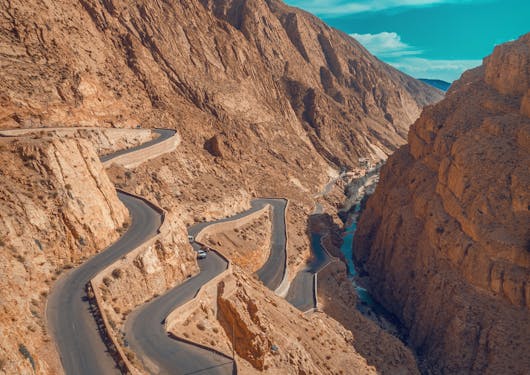
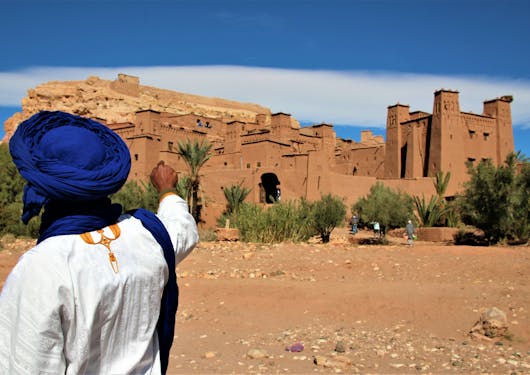
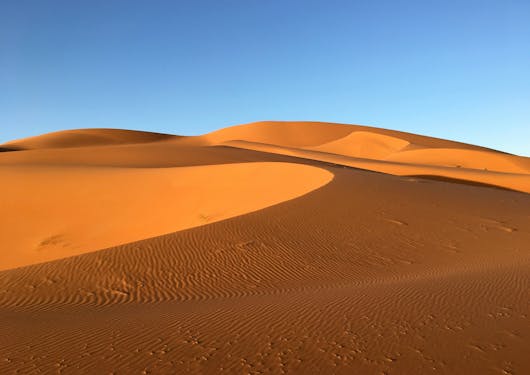
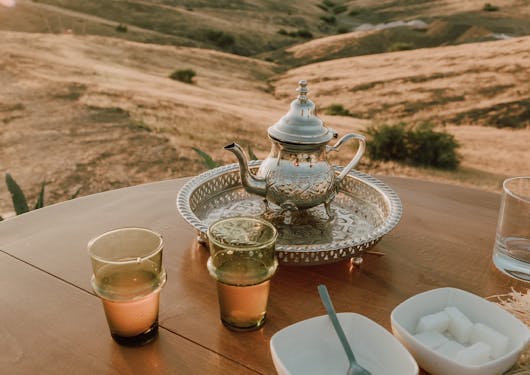
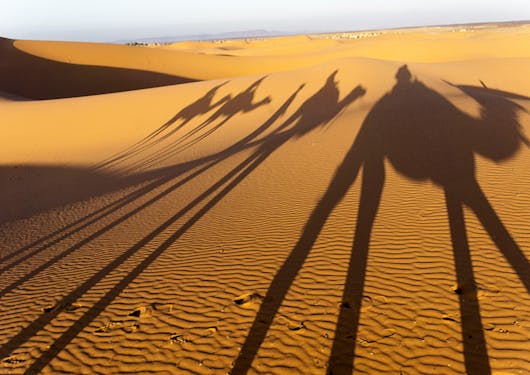
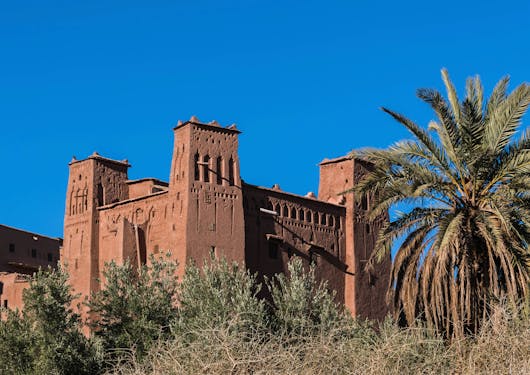
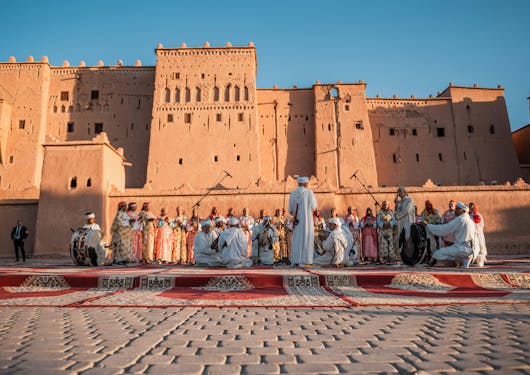

This Sahara Desert excursion in Morocco requires a lot of driving, therefore you should be prepared to sit for 1.5-2 hour intervals as your driver will make stops along the way. During these stops, you can stretch your legs, take in scenic view points, eat lunch, and explore - depending on the duration of the stop.
We do not recommend visiting the Sahara Desert as a single overnight journey, and suggest a minimum of two nights. From Marrakech to the desert, you will stop about mid-way in Ouarzazate (about 3.5 hours), explore the ksars and kasbahs there, and stay overnight. From Ouarzazate, the rest of the way to the desert is about 5.5 hours, and you'll stay in the desert the second night. On the following day, the drive time from the desert to Fez is about 7 hours, and, as on the way out to the desert, you'll stop every 1.5-2 hours for viewpoints and villages.
Is riding a camel sustainable?
Riding a camel can be considered sustainable, depending on how it's managed. Here are a few factors to consider. If you are not comfortable with participating in a safari camel trek, you can opt out of this with our full understanding and support.
Animal Welfare: Unlike riding elephants, where the gentle giants are 'broken' and abused to accommodate human riders, camels can be trained humanely, much like horses. They can be domesticated, socialized young, and become accustomed to halters, saddles, and commands. Companies offering camel rides should treat the animals well, feed them properly, and not overwork them.
Environmental Impact: Camels have been a transportation method for humans for thousands of years. They were particularly important for trade and transport in desert areas thanks to their ability to traverse long distances with little water. While now also used for tourism, camels are an important way for visitors to see beautiful, remote natural areas without the use of a motorized car.
Cultural & Economic Implications: Camels are ingrained in the traditional fabric of desert communities. Riding them responsibly can preserve an ancient practice, provide economic support for their owners, and foster respect and appreciation for their importance to locals.
Seasonal Notes
Spring (March-May) and fall (September-November) are typically the best seasons to visit Morocco's Sahara Desert. You can visit in the summer and winter months if you are prepared for extreme hot and cold temperatures - this wouldn't be our first recommendation! This itinerary does include air-conditioned vehicles and lodging to accommodate summer travel.
Itinerary
Day 1 Marrakech to the 'Gateway to the Sahara' [Morocco]
Day 2 Ouarzazate to the Sahara Desert
Days 3 Sahara Desert to Fez
Customization
Route Map

Inclusions & Exclusions
Handpicked 4* or similar accommodations, including a luxury desert camp with AC
2 breakfasts, 2 dinners (traditional meals)
Campfire with traditional Gnawa music
Transportation in a Mercedes Vito or Ford with AC with a professional driver/guide
24/7 Ground assistance
International flights
Meals not mentioned
Alcohol and personal expenses
Insurance, Visa, Taxes, Tips
Pricing
Prices exclude flights to/from the destination.
Prices are for double room occupancy unless indicated otherwise.
This itinerary was designed for a group of 5; please inform us of your group size for the most accurate pricing.
Deposit per person
30% of the trip price
Shared Room - sleeps 2 - price per person
$390
Sustainability
We focus on impactful experiences based on quality, authenticity, and sustainability. Our crew and drivers are all extremely knowledgeable and experienced, and we choose smaller-scale, locally-owned accommodations and boutique hotels.
We buy locally-produced food and drinks and dine in locally-owned restaurants. We strive to minimize plastic waste wherever possible and carefully manage limited energy and water resources. We operate with a ‘leave no trace’ ethos – take only memories, leave only footprints.
Environmental Initiatives
We take you closer to the most remote environmental landscapes of Morocco. We tell you all about the sustainable initiatives done by the local population. For example, we can share how the construction materials keep the houses warm during winter and cold during summer, or about the reusable objects and the agricultural systems.
We make a financial contribution to plant trees in nurseries managed by our partner, High Atlas Foundation, in order to help offset the carbon footprint of our travelers.
Sociocultural Initiatives
This itinerary was designed to offer real-life experiences that promote cross-cultural understanding.
Economic Initiatives
All our partners are Moroccan, and we make sure that we pay them fairly to be sustainable for them. We also make sure to visit remote areas you likely wouldn't find by yourself, and where you could have the most impactful experience.
Health & Safety
Be sure you have traveler's insurance.
FAQs
What does the Physical Rating of "Easy" mean?
This itinerary is not physically rigorous, but it does require long drives ranging from 3.5 to 7 hours. You will be able to stop every 1.5-2 hours, but must be comfortable sitting for the driving intervals.
What are the accommodations like?
We have handpicked 4* or similar accommodations, including a luxury desert camp with air conditioning.


